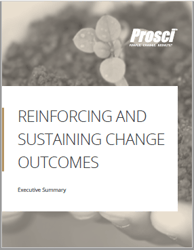What is resistance to change, why is it important and are you aware of how it’s affecting your change initiatives?
In this blog we will look at:
- What is Change Resistance?
- The Different Types of Resistance
- What are the Symptoms of Resistance?
- Why does Resistance to Change Happen?
- How to Overcome Resistance
What is Change Resistance?
Prosci® describes change as going from the current state, through the transition state, to the future state. Think of the current state as the comfort zone, and the future state as uncertainty. It is inevitable that this will bring about pockets of resistance in your organisation.
These pockets of change resistance can rear their heads in a variety of forms such as; Fear, anxiety, reduced productivity, avoidance and being outwardly negative about the change.
Resistance is a natural response to change; people tend to gravitate towards the current state of process because it is safe and known. Humans as a rule are programmed to fear the unknown, and unless resistance is planned for and mitigated effectively the future state of a change initiative will not necessarily be realised.
Many organisations are surprised by resistance and fail to see that it is something that can be utilised to improve your initiative rather than hinder it.
If resistance is ignored however, your initiative will likely encounter delays, a lower ROI, extra costs, creating a history of failed change management and most importantly, losing valued employees.
Types of Resistance to Change
As mentioned, resistance can appear in different forms, which can be categorised into different types of resistance. This resistance might also manifest itself in one employee or the workplace as a whole. For example:
Political resistance
Political resistance occurs when organisation members think that there's a chance, they will lose something of value when the change is implemented.
Ideological Resistance
Ideological resistance to change is firmly rooted in an employee's beliefs. These employees may believe that a new direction violates the fundamental values held by the organisation.
Social Resistance
For example, you might experience social resistance within a tight-knit organisation. Managers may feel compelled to resist your proposed change if it means protecting their co-workers.
What are the Symptoms of Resistance to Change?
So, know we know what types of resistance there are, how do we tell when it’s happening?
Resistance is evident in actions such as:
- Acting out – When an employee or group is acting out, they may cause conflict, be passive aggressive and even celebrate failure.
- Avoidance: When an employee is avoiding the change, they may, miss meetings, ignore the change and revert to old behaviours.
- Negativity: When an employee is being negative this may be shown by, objections, complaining and rumour spreading.
- Disengaging: When an employee is disengaged from the change, they may be quiet, indifferent and ignore communication.
- Control: When an employee tries to control the change, they will ask a lot of questions, defend the current state and try to influence outcomes.
- Building barriers: When an employee is building barriers, they can use excuses, recruit dissenters and use counter-approaches to resist the change.
An employee who has a higher position and more seniority might be more resolute in their stance against change. Managers and directors resist the change for different reasons, but it is imperative that your people managers and sponsors are on-board with the change initiative otherwise failure is inevitable.
The importance of people managers having the competence to effectively communicate change, cannot be dismissed. Prosci’s research tells us that employees want to hear business-wide messages from their CEO, but want to hear those WIIFM (what’s in it for me) messages from their direct line manager.
If we reference to Prosci’s famous ADKAR model, desire is going to be heavily impacted by the answer to the question, “what’s in it for me?”. So therefore, line managers have a hugely critical role in progressing their reports through the ADKAR model, which in turn, contributes to the likelihood of project success.
Why Does Resistance Happen?
Resistance can happen for a multitude of reasons, but ultimately, resistance happens due to poorly managed change. Therefore, in order to pinpoint why the resistance is happening, it can certainly help to know what part of the change management process is falling short.
Common “pain points” in change management, that can be a root cause of resistance include, but are not limited to:
- Sponsors not fulfilling their role effectively
- Lack of a common change management framework
- Lack of awareness of why the change has been implemented
- Lack of inclusion
- Fear of impact on job/job role
To learn more about how to identify root causes of resistance, take a look at CMC’s Webinar on managing resistance.
Free Download: Managing Resistance to Change

What can we do to Overcome Resistance to Change?
So, we know that resistance is natural, we know why it can happen and what the root causes of it can be, what can we do to overcome resistance when it appears?
As mentioned previously in the blog, resistance ultimately occurs because of poorly managed change. That being said, resistance is still not going to be completely eliminated. Even the most positive change you can imagine, will still not please everyone.
Prosci offer two approaches to managing resistance wherever you are in your change journey.
- Resistance prevention
If we set out to manage change properly from the get-go, then we can put some pre-measures in place to manage resistance. By engaging sponsors, equipping managers, and providing adequate training to impacted groups, we can give ourselves a solid foundation.
Before we commence the change, where can we foresee the pockets of resistance forming? Particular individuals who are often resistant? Groups and teams that are more negatively affected than others? Once we have identified this, we know then where to focus our change management efforts.
As a line manager, catching up with your team regularly, can help provide them the forum to air their change grievances, which can go a long with in preventing resistance from occurring. Read this blog to find out more about how best to conduct these conversations.
- Resistance Response
If resistance is already prevalent, we can still react in a timely and targeted manner in order to stop said resistance from growing. Prosci have listed 3 steps to address if resistance is already occurring.
- Identify the root cause of the resistance (ADKAR® assessments can be used to help determine this).
- Once the root cause is identified, a range of activities come into play in order to listen to concerns and remove any blockers.
- Enable and empower resistance managers
Prosci also list 6 Tips for minimising resistance. These are:
- Communicate early and often
- Listen to employees
- Educate employees on the value of change
- Name emotions
- Timing is everything
- Provide ongoing support
Free Download: Reinforcing and Sustaining Change Outcomes

How do we future proof Change Initiatives against Resistance?
So, with that, how can we ensure that we are equipped to deal with resistance in future?
Focus on your Line Managers
We mention earlier in the blog about the importance of line managers in communicating and supporting their direct reports through change. They are ‘key in building support and mitigating resistance during a change’.
Therefore, creating an environment where our line managers fully understand, and are 100% confident in their role, will go a long way to future-proofing future initiatives.
You may wish to consider organising a Prosci Leading your Teams Through Change Workshop for line managers in your organisation, so that they can be fully trained in how to support their direct reports through change.
Invest in change management
Regardless of whether or not you invest in change management training and infrastructure, it will inevitably cost you.
In the absence of good change management in your organisation, the likelihood that your projects and initiatives fail increases. In the event that this happens, there are two possible results.
- You will launch a separate project following the change project to drive adoption and usage, or...
- You will not launch a separate project, and the organisation will not achieve its return on investment
Therefore, if you invest in change management training and infrastructure, you will not only future-proof against resistance, and achieve your desired outcomes. You will also be saving yourself money in the long term.
Start your Journey towards Enterprise Change Management
A big step towards future proofing against resistance, is to implement an organisational approach to change management (Known as enterprise change management), as opposed to implementing change management on a project-by-project basis.
If the whole organisation is singing from the same hymn sheet, then it makes it much easier to support all our employees through change, and therefore mitigate resistance from occurring.
A single, consistent approach will mean everyone is on the same page and allow the organisation to be able to act swiftly in a world where constant change is happening. It really does pay to have a consistent methodology.
We also offer private on-site training, contact us for more information.


